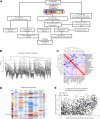Immune-Inhibitory Gene Expression is Positively Correlated with Overall Immune Activity and Predicts Increased Survival Probability of Cervical and Head and Neck Cancer Patients
- PMID: 33834038
- PMCID: PMC8021786
- DOI: 10.3389/fmolb.2021.622643
Immune-Inhibitory Gene Expression is Positively Correlated with Overall Immune Activity and Predicts Increased Survival Probability of Cervical and Head and Neck Cancer Patients
Abstract
Background: Limited immunotherapy options are approved for the treatment of cervical cancer and only 10-25% of patients respond effectively to checkpoint inhibition monotherapy. To aid the development of novel therapeutic immune targets, we aimed to explore survival-associated immune biomarkers and co-expressed immune networks in cervical cancer. Methods: Using The Cancer Genome Atlas (TCGA) Cervical Squamous Cell Carcinoma (CESC) data (n = 304), we performed weighted gene co-expression network analysis (WGCNA), and determined which co-expressed immune-related genes and networks are associated with survival probability in CESC patients under conventional therapy. A "Pan-Immune Score" and "Immune Suppression Score" was generated based on expression of survival-associated co-expressed immune networks and immune suppressive genes, which were subsequently tested for association with survival probablity using the TCGA Head Neck Squamous Cell Carcinoma (HNSCC) data (n = 528), representing a second SCC cancer type. Results: In CESC, WGCNA identified a co-expression module enriched in immune response related genes, including 462 genes where high expression was associated with increased survival probability, and enriched for genes associated with T cell receptor, cytokine and chemokine signaling. However, a high level of expression of 43 of the genes in this module was associated with decreased survival probability but were not enriched in particular pathways. Separately, we identified 20 genes associated with immune suppression including inhibitory immune checkpoint and regulatory T cell-related genes, where high expression was associated with increased survival probability. Expression of these 20 immune suppressive genes (represented as "Immune Suppression Score") was highly correlated with expression of overall survival-associated immune genes (represented as "Pan-Immune Score"). However, high expression of seven immune suppression genes, including TWEAK-R, CD73, IL1 family and TGFb family genes, was significantly associated with decreased survival probability. Both scores also significantly associated with survival probability in HNSCC, and correlated with the previously established "Immunophenoscore." Conclusion: CESC and HNSCC tumors expressing genes predictive of T cell infiltrates (hot tumors) have a better prognosis, despite simultaneous expression of many immune inhibitory genes, than tumors lacking expression of genes associated with T cell infiltrates (cold tumors) whether or not these tumor express immune inhibitory genes.
Keywords: cervical cancer; head and neck cancer; immune checkpoints; immune inhibition; inflamed tumours; prognosis.
Copyright © 2021 Budhwani, Turrell, Yu, Frazer, Mehdi and Chandra.
Conflict of interest statement
The authors declare that the research was conducted in the absence of any commercial or financial relationships that could be construed as a potential conflict of interest.
Figures






Similar articles
-
HPV status represents dominant trait driving delineation of survival-associated gene co-expression networks in head and neck cancer.Cancer Gene Ther. 2023 Apr;30(4):629-640. doi: 10.1038/s41417-022-00577-9. Epub 2022 Dec 27. Cancer Gene Ther. 2023. PMID: 36575316 Free PMC article.
-
Exploration of a Robust and Prognostic Immune Related Gene Signature for Cervical Squamous Cell Carcinoma.Front Mol Biosci. 2021 Mar 3;8:625470. doi: 10.3389/fmolb.2021.625470. eCollection 2021. Front Mol Biosci. 2021. PMID: 33748188 Free PMC article.
-
Identification of Stemness-Related Genes for Cervical Squamous Cell Carcinoma and Endocervical Adenocarcinoma by Integrated Bioinformatics Analysis.Front Cell Dev Biol. 2021 Mar 25;9:642724. doi: 10.3389/fcell.2021.642724. eCollection 2021. Front Cell Dev Biol. 2021. PMID: 33842467 Free PMC article.
-
Integration of scRNA-Seq and TCGA RNA-Seq to Analyze the Heterogeneity of HPV+ and HPV- Cervical Cancer Immune Cells and Establish Molecular Risk Models.Front Oncol. 2022 Jun 1;12:860900. doi: 10.3389/fonc.2022.860900. eCollection 2022. Front Oncol. 2022. PMID: 35719936 Free PMC article.
-
Current Understanding of the Mechanisms Underlying Immune Evasion From PD-1/PD-L1 Immune Checkpoint Blockade in Head and Neck Cancer.Front Oncol. 2020 Feb 28;10:268. doi: 10.3389/fonc.2020.00268. eCollection 2020. Front Oncol. 2020. PMID: 32185135 Free PMC article. Review.
Cited by
-
HPV status represents dominant trait driving delineation of survival-associated gene co-expression networks in head and neck cancer.Cancer Gene Ther. 2023 Apr;30(4):629-640. doi: 10.1038/s41417-022-00577-9. Epub 2022 Dec 27. Cancer Gene Ther. 2023. PMID: 36575316 Free PMC article.
-
Multi-omics and AI-driven immune subtyping to optimize neoantigen-based vaccines for colorectal cancer.Sci Rep. 2025 Jun 2;15(1):19333. doi: 10.1038/s41598-025-01680-1. Sci Rep. 2025. PMID: 40456769 Free PMC article.
-
A model of impaired Langerhans cell maturation associated with HPV induced epithelial hyperplasia.iScience. 2021 Oct 21;24(11):103326. doi: 10.1016/j.isci.2021.103326. eCollection 2021 Nov 19. iScience. 2021. PMID: 34805788 Free PMC article.
-
Radiomics-based model for prediction of TGF-β1 expression in head and neck squamous cell carcinoma.Am J Nucl Med Mol Imaging. 2024 Aug 25;14(4):239-252. doi: 10.62347/JMKV7596. eCollection 2024. Am J Nucl Med Mol Imaging. 2024. PMID: 39309414 Free PMC article.
-
Immune and inflammation: related factor alterations as biomarkers for predicting prognosis and responsiveness to PD-1 monoclonal antibodies in cervical cancer.Discov Oncol. 2022 Sep 28;13(1):96. doi: 10.1007/s12672-022-00560-8. Discov Oncol. 2022. PMID: 36171464 Free PMC article.
References
LinkOut - more resources
Full Text Sources
Other Literature Sources
Research Materials

